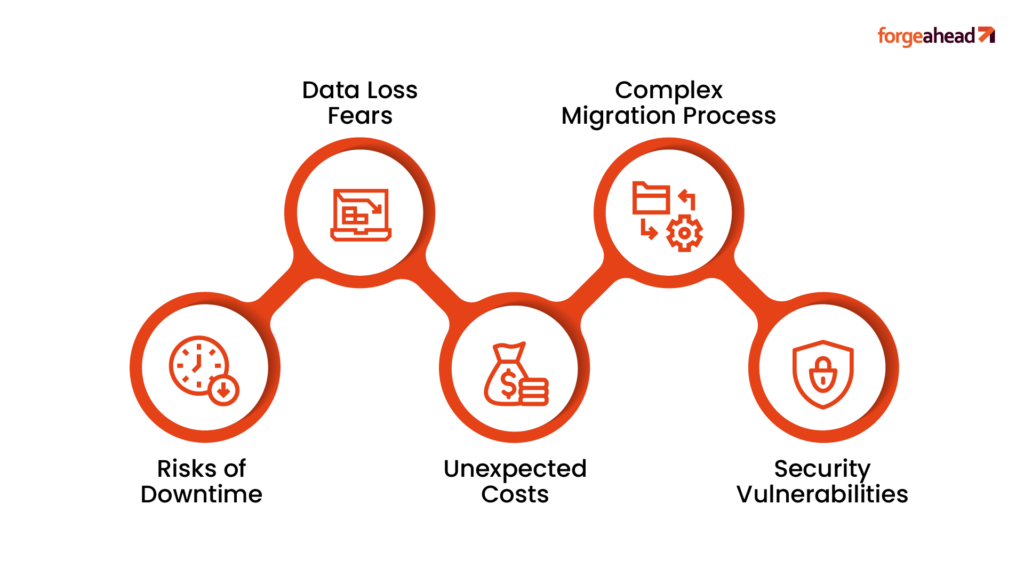Last updated on April 5th, 2024
In an era where cloud computing is not just a trend but a business necessity, AWS Cloud Migration stands out as a pivotal step for companies seeking to leverage the power of the cloud. This process involves transferring applications, data, and IT processes from on-premises data centres to Amazon Web Services (AWS) – a platform known for its reliability, scalability, and a wide array of services.
However, as promising as this transition appears, it’s fraught with complexities and potential risks. Understanding and strategically mitigating these risks are crucial for any business to ensure a smooth, secure, and cost-effective migration.
In this blog, we delve into the common pitfalls associated with AWS Cloud Migration and provide practical strategies to navigate these challenges successfully, ensuring that the transition bolsters rather than hinders your business operations.
In the digital age, cloud computing is the invisible force enabling new paradigms of business, creativity, and innovation. It’s not just about accessing information; it’s about using the limitless power of the cloud to solve problems in ways we’ve yet to imagine.
– Satya Nadella, CEO, Microsoft
Understanding AWS Cloud Migration
The Process of Moving to the Cloud
AWS Cloud Migration is a multifaceted process that involves transferring a company’s digital assets — such as applications, databases, server processes, and IT resources — from their current on-premises data centres to Amazon Web Services (AWS). This platform is renowned for its reliability, scalability, and diverse range of services. The migration goes beyond a mere data shift; it’s a strategic upgrade to a more adaptable, scalable, and efficient
Why It Matters in Today’s Tech Landscape
In the current, rapidly-evolving tech environment, agility and adaptability are key to staying competitive. AWS Cloud Migration provides businesses with the elasticity to scale resources as needed, offering access to a broad spectrum of tools and services, thereby enhancing operational efficiency. This migration can lead to significant cost savings, transitioning from a capital expense model to a variable expense framework where expenses are based on actual usage of computing resources.
Strategic Advantages for Businesses
The move to AWS isn’t just about keeping pace with tech trends; it’s a strategic decision to harness the power of cloud computing for fostering innovation, agility, and expanding global reach. Utilising AWS’s robust infrastructure, companies can not only advance their data analytics capabilities but also strengthen cybersecurity, and improve disaster recovery and business continuity strategies.
AWS Cloud Migration represents a vital step for businesses aiming to modernise and excel in a digital-centric market. It’s not just a technological shift but an operational revolution, aligning with market and customer needs.
Common Pitfalls in AWS Cloud Migration

Risks of Downtime
One of the foremost challenges during AWS Cloud Migration is the risk of operational downtime. The transition, if not managed meticulously, can disrupt ongoing business operations. This downtime not only affects day-to-day functionalities but can also lead to revenue loss and customer dissatisfaction. Businesses must plan the migration carefully, often staging it in phases, to minimise the impact on their core operations.
Data Loss Fears
The potential for data loss during migration is a significant concern. This fear stems from the possibility of data being corrupted or lost in transit. Such an event can have far-reaching consequences, including the loss of critical business information and erosion of customer trust. Ensuring data integrity involves rigorous backup procedures and data verification protocols both before and after the migration.
Unexpected Costs
Budget overruns are a common pitfall in AWS Cloud Migration. These unexpected costs often arise from underestimating the resources required for the migration, unforeseen technical challenges, or extended timelines. To manage financial risks, it’s important to have a well-defined budget that includes contingency allowances for unexpected expenses.
Complexity of the Migration Process
The complexity of migrating to AWS cannot be understated. It involves meticulous planning, skilled resource allocation, and an understanding of the technical intricacies. Errors in execution, from data misconfiguration to incorrect resource allocation, can lead to significant setbacks. Adequate training and possibly partnering with experienced cloud migration service providers can mitigate these risks.
Security Vulnerabilities
Finally, security vulnerabilities are a critical concern. The migration process can expose organisations to new security threats and compliance challenges. Ensuring the security of data during the migration involves a comprehensive review of security protocols, adhering to best practices, and continuous monitoring for potential breaches.
While AWS Cloud Migration offers numerous benefits, it’s imperative to be aware of and prepared for these common pitfalls. Understanding these risks and implementing strategic measures to counter them ensures a smoother and more successful migration experience.
Real-World Examples and Case Studies in AWS Cloud Migration
In the realm of AWS Cloud Migration, real-world case studies offer invaluable insights into the challenges and successes encountered by businesses. Forgeahead, an expert in cloud migration services, showcases several case studies that highlight the intricacies and triumphs of navigating the AWS Cloud Migration process.
One notable case involves a cloud-based startup founded in 2020, during the COVID pandemic. This company aimed to simplify contact tracing and asset management across industries using telemetry data. Forgeahead developed a customised application using serverless architecture, which provided deep visibility and real-time monitoring of organisational assets. This solution not only enhanced operational safety and efficiency but also ensured business continuity during challenging times. The addition of a contact tracing functionality further helped in mitigating the spread of infectious diseases.
Another example is from a company based in San Francisco that wanted to offer a unified digital platform for solar project management to its global clients. The client sought Forgeahead’s expertise to create a comprehensive dashboard for solar panel developers, installers, and end-users. By leveraging AWS Serverless technologies, Forgeahead developed a versatile, metric-driven platform that allowed users to track solar power performance, streamline operations, and reduce costs. This platform now processes solar projects worth over $1 billion annually.
These case studies exemplify the potential challenges and solutions in AWS Cloud Migration. The first case illustrates how businesses can leverage cloud technology for real-time asset tracking and management, enhancing both safety and operational efficiency. The second case demonstrates the effective use of serverless architecture to create scalable, cost-effective solutions for energy management, providing real-time insights and operational control.
Strategies to Mitigate Risks in AWS Cloud Migration
Mitigating risks during AWS Cloud Migration involves understanding common pitfalls and implementing strategic measures to counter them. Below are insights and practical strategies for a smooth migration process.
Understanding Common Challenges
- Downtime Risks: Recognize that migrating to the cloud can disrupt operations if not managed well.
- Data Loss: The possibility of losing data during migration is a major concern that can have lasting impacts.
- Cost Overruns: Unplanned expenses can strain your budget.
- Migration Complexity: The intricate nature of migration can lead to errors.
- Security Threats: The migration process can open up vulnerabilities in your system.
Preventive Strategies
- Planning and Testing: Develop a comprehensive migration plan and conduct thorough testing to anticipate potential problems.
- Data Backup: Ensure all data is backed up before migration to prevent loss.
- Budgeting: Prepare a detailed budget with a buffer for unexpected costs.
- Training: Equip your team with the necessary skills and knowledge for a smooth migration.
Risk Mitigation Tactics
- Minimise Downtime: Implement migration in phases to reduce operational disruptions.
- Data Integrity Measures: Use data verification tools to ensure data integrity during and after the migration.
- Cost Management: Monitor expenses closely and adjust resources as needed to stay within budget.
- Efficiency in Migration: Streamline the migration process by using automation tools where possible.
Best Practices for Secure and Efficient Migration
- Security First: Prioritise security measures to protect data during the migration. Implement strong encryption and access controls.
- Compliance: Ensure that your migration adheres to industry standards and regulations.
- Partner with Experts: Consider partnering with experienced cloud migration service providers for their expertise and support.
- Continuous Monitoring: Keep a close eye on the migration process, looking out for any anomalies or issues.
By adhering to these strategies and best practices, businesses can significantly reduce the risks associated with AWS Cloud Migration. This approach not only ensures a secure and efficient migration but also positions the business for success in its new cloud environment.

Wrapping Up: Mastering AWS Cloud Migration
Throughout this blog, we’ve explored the various challenges and strategies associated with AWS Cloud Migration. We delved into the common pitfalls, including risks of downtime, data loss fears, unexpected costs, complexities of the migration process, and security vulnerabilities. By understanding these challenges, businesses can prepare effectively, ensuring a smoother transition to the cloud. We also discussed practical strategies for mitigating these risks, emphasising the importance of planning, data integrity, cost management, and security measures. Implementing these strategies is crucial for a successful and secure migration, positioning your business to leverage the full potential of AWS Cloud services.
Engage with Experts: Your AWS Cloud Migration Journey with Forgeahead
Embarking on AWS Cloud Migration? Forgeahead stands ready to assist with their expertise in cloud migration services. They offer a wealth of knowledge and support to help navigate the complexities of cloud migration.
FAQs
1. What Are the Key Benefits of Migrating to AWS Cloud?
The key benefits include increased scalability, improved data security, cost efficiency, enhanced performance, and access to a broad range of advanced cloud services.
2. How Long Does a Typical AWS Cloud Migration Take?
The duration varies depending on the complexity and size of the existing infrastructure. Small migrations might take a few weeks, while larger, more complex migrations can take several months or more.
3. What Are the Biggest Challenges in AWS Cloud Migration?
Common challenges include managing downtime risks, preventing data loss, controlling unexpected costs, navigating the complexity of the migration process, and ensuring robust security measures.
How does AWS Lambda support rapid prototyping and innovation in startups?
Yes, migrating to AWS Cloud can lead to significant cost savings due to its pay-as-you-go pricing model, reduced hardware maintenance costs, and improved operational efficiency.
5. Is it Necessary to Partner with a Cloud Migration Service Provider Like Forgeahead?
While not mandatory, partnering with experienced providers like Forgeahead can significantly ease the migration process. They provide expertise in planning, execution, and managing potential risks, ensuring a smoother and more successful migration.



